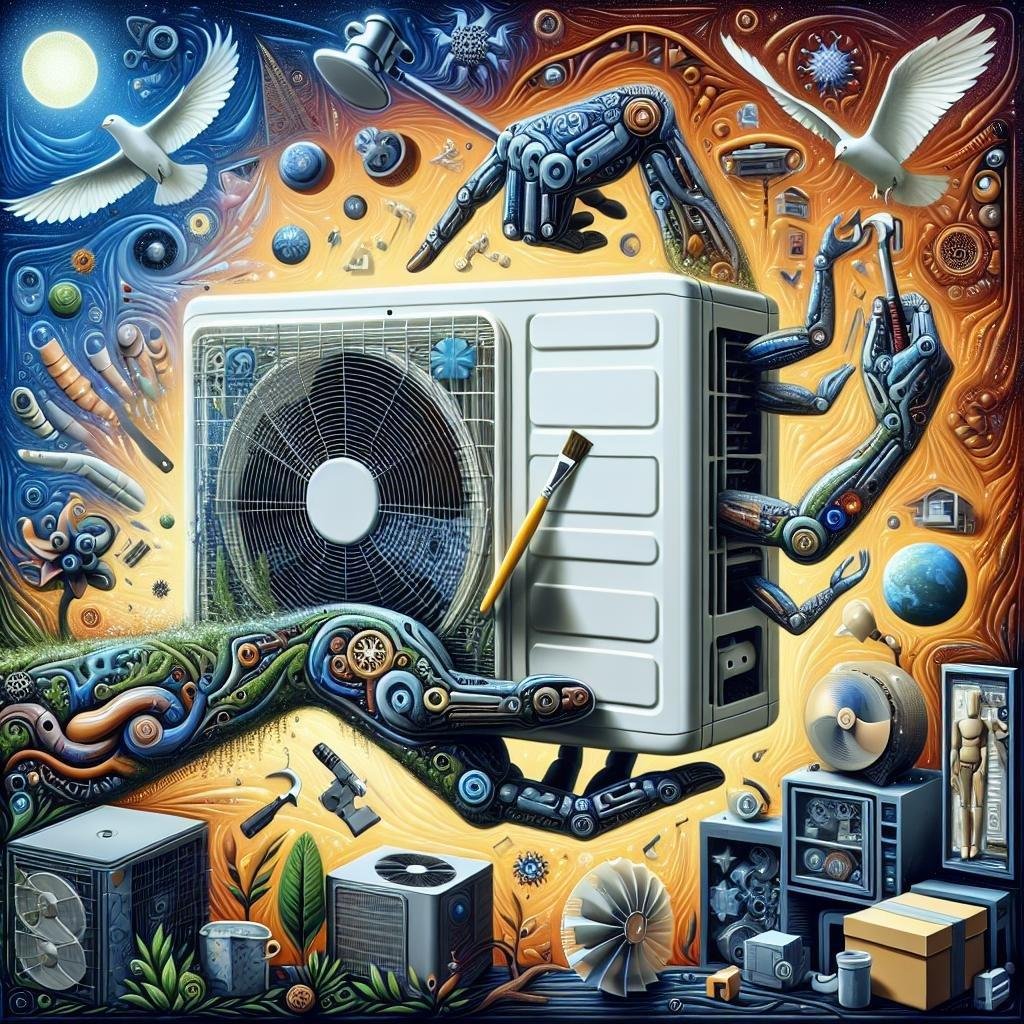Can I install a mini split AC unit myself?

Picture this: its a scorching summer day, and you’re staring at that plain wall in your home, dreaming of cool, refreshing air. The thought of a sleek mini-split AC unit catches your fancy, but your wallet isn’t too thrilled about professional installation costs. Sound familiar? You’re not alone in wondering if you can channel your inner DIY superhero and tackle this project yourself. Let’s dive into the world of mini-split installation, where homeowner ambition meets technical reality, and discover whether you’ve got what it takes to keep your cool – literally and figuratively.
DIY Mini Split Installation: What You Need to Know Before Taking the Plunge
If you’re a seasoned DIY enthusiast with basic electrical and HVAC knowledge, tackling a mini split installation might be right up your alley. While manufacturers like Mr. Cool specifically design DIY-kind systems, you’ll need to familiarize yourself with essential components and tools before starting the project. The most critical aspects include:
- A high-quality drill and mounting bracket kit
- Line-set installation tools (flaring tool, tubing cutter)
- vacuum pump for proper refrigerant charging
- Level and stud finder for accurate wall mounting
- Basic electrical tools and outdoor disconnect box
The success of your mini split DIY adventure heavily depends on proper planning and readiness. You’ll need to determine the ideal location for both indoor and outdoor units, considering factors like sun exposure, drainage paths, and structural support. Don’t forget to check local building codes and obtain necessary permits – some jurisdictions require licensed professionals for HVAC installations. Most DIYers can handle the indoor unit mounting and line-set routing, but the electrical connection and refrigerant charging are where things get tricky.
| DIY Skill Level | Time Required | Cost Savings |
|---|---|---|
| Advanced | 1-2 days | 40-60% |
Essential Tools and Skills Required for a Successful Mini Split Setup
Before diving into your DIY mini split installation journey, you’ll need to gather a thorough set of tools to ensure a smooth process. The basics include a vacuum pump, manifold gauge set, and flaring tool kit for proper refrigerant line preparation. You’ll also want to have these handy items within reach:
- Level and tape measure
- Drill with various bits
- Wire strippers and crimpers
- Torque wrench
- Core removal tool
Beyond the physical tools, successful installation demands specific technical skills and knowledge. Understanding basic electrical concepts, being pleasant with reading manufacturer specifications, and having experience with proper mounting techniques are crucial.You’ll need to master the art of creating flawless flare connections and know how to properly evacuate the system. Some jurisdictions might require EPA Section 608 certification for handling refrigerants, so it’s worth checking local regulations before starting your project.
| Skill Level | Tools Investment | Time Required |
|---|---|---|
| Intermediate | $300-$500 | 4-8 hours |
critical Steps and Common Pitfalls in Self-Installing Your Mini Split System
While proper planning and preparation are essential for a successful DIY installation, several key elements demand your attention. Begin by carefully measuring your space and selecting an appropriate location for both indoor and outdoor units, ensuring proper clearance and accessibility. Pay special attention to the refrigerant line length requirements and voltage specifications of your chosen system. Many DIY enthusiasts overlook the importance of proper drainage slope and secure mounting brackets, which can lead to water damage and unit instability over time.
First-time installers often encounter challenges that can be easily avoided with proper awareness. Vacuum testing the refrigerant lines is crucial yet frequently rushed, leading to system inefficiency and potential failures. Keep your flaring tool precisely aligned to prevent refrigerant leaks, and avoid overtightening connections, which can damage the flare fittings.
| Common Error | Impact | Prevention |
|---|---|---|
| Incorrect Line Set Length | Reduced Efficiency | Pre-measure Twice |
| Poor Flare Connection | Refrigerant Leaks | Use Proper Tools |
| Insufficient Vacuum | system Failure | Test Thoroughly |
Expert Tips to Ensure Your DIY Mini Split Installation Meets Professional Standards
Achieving a flawless DIY mini split installation requires meticulous attention to detail and the right preparation. Start by carefully selecting your mounting location, ensuring it’s on a sturdy wall with proper clearance and minimal sun exposure. Before drilling any holes, use a stud finder and level to mark your bracket position, and don’t forget to check for hidden pipes or electrical wiring. The refrigerant line set requires special handling – create a gentle bend without kinking the copper tubing, and maintain a slight downward angle for proper condensate drainage.
Take your time with the electrical connections, as this is where many DIY installations fall short. Consider these crucial steps for professional-grade results:
- Use a dedicated circuit breaker sized specifically for your unit
- Install a disconnect box within arm’s reach of the outdoor unit
- Apply dielectric grease to prevent terminal corrosion
- Secure all wiring with appropriate conduit and weatherproof connections
- Double-check torque specifications on all flare connections
| Common Mistake | Pro Solution |
|---|---|
| Unlevel mounting | Use laser level tool |
| Incorrect flaring | Invest in quality flaring tool |
| Poor insulation | Apply UV-resistant foam |
Q&A
Q&A: Can I Install a Mini Split AC Unit Myself?
Q1: What exactly is a mini split AC unit?
A: Great question! A mini split AC unit is a sleek, ductless air conditioning system that consists of an outdoor compressor and one or more indoor units. They’re known for their energy efficiency, quiet operation, and ability to control the temperature in individual rooms. Think of them as the stylish cousins of conventional AC units!
Q2: Is it possible for me to install a mini split AC unit on my own?
A: Absolutely, you can install it yourself, but it comes with a few caveats! If you’re handy, have a good set of tools, and are comfortable working with basic electrical and plumbing systems, you might find the process doable. Just imagine yourself wielding the instruction manual like a pro-though you might want to keep that coffee pot filled for a little boost!
Q3: What do I need to consider before diving into DIY installation?
A: It’s important to consider your skill level and whether you’re familiar with wiring, refrigerant lines, and wall mounting. Also,keep local building codes in mind; you may need a permit or have to follow specific regulations. It might be like preparing for a cooking competition-gather all your ingredients (tools and data) before you start.
Q4: What tools will I need to complete the installation?
A: Prepare for a little toolbox party! You’ll typically need a drill, stud finder, wrenches, a level, and insulation tape. Don’t forget gloves and safety glasses! It’s a fun adventure, just like a treasure hunt, but with more sweat and fewer buried gold coins.
Q5: Are there any steps in the process that might trip me up?
A: Some tricky bits might include ensuring proper refrigerant line installation, setting the right electrical connections, and achieving correct placement of indoor units for optimal airflow. Think of these as the tricky puzzles in a jigsaw-just when you think you’re finished, one piece doesn’t fit, and you need to go back and adjust!
Q6: What are the potential risks of DIY installation?
A: While DIY installation can be rewarding, there are risks! Improper installation can lead to inefficiency, higher energy bills, and even potential damage to the unit. In some cases, it might void the warranty. If you feel like you’re venturing into the unknown too much, don’t hesitate to call in a professional for a helping hand. Better safe than sweating!
Q7: How do I know if I shoudl just hire a professional instead?
A: If you start feeling like a deer in headlights at the thought of handling electrical wiring, or if the technical jargon makes you dizzy, it might be wise to enlist the help of a pro.Just like you wouldn’t perform brain surgery on yourself, when it comes to cool air, sometimes it’s best to leave it to the experts!
Q8: Are there benefits to hiring a professional anyway?
A: Totally! Professionals can ensure your mini split is installed safely, efficiently, and in compliance with local codes. Plus, many guarantee their work, which means peace of mind for you.Think of it as hiring a personal trainer for your air conditioning-it’s all about getting the best performance!
Q9: Any final tips for future DIYers?
A: Of course! Make sure you read the installation manual thoroughly, watch some helpful videos, and don’t hesitate to reach out to online forums for additional tips. Take your time, enjoy the journey, and before you know it, you might just be the proud parent of a perfectly cool mini split AC unit. Happy installing!
Key Takeaways
As we wrap up our exploration of the DIY journey with mini-split AC units, it’s clear that while the allure of home betterment is strong, the path to a cooler, more comfortable living space can come with its share of twists and turns. Whether you’re a seasoned handyman or a curious novice, the decision to install a mini-split system yourself is one that requires thoughtful consideration and a sprinkle of caution.
Remember, these systems bring not just air conditioning but also a sense of pride in a job well done-if you take the time to educate yourself, plan meticulously, and perhaps call in reinforcements when needed. If you choose to tackle this project, embrace the challenge! But if any doubts linger, don’t hesitate to reach out to the professionals-they’re just a call away and ready to help transform your home into a refreshing oasis.
whether you’re sweating it out in the summer heat, dreaming of better airflow, or ready to dive into the rewarding world of home improvements, know that every step taken towards your goal, big or small, is a step in the right direction. Here’s to cool breezes and the comfort of home, no matter how you choose to achieve it! cheers!






















